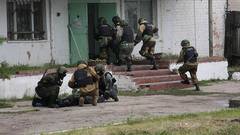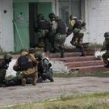
BRIEFS
Publication: Terrorism Monitor Volume: 12 Issue: 19
By:

REAPPEARANCE OF ‘SLAIN’ DAGESTANI MILITANT DISPROVES FSB CLAIMS
Mairbek Vatchagaev
Practically every month, Moscow boastfully announces that it has killed a leader of one of the territorial branches of the Islamic underground armed resistance. Statistics regularly provided by Russian authorities concerning the insurgency raise doubts about the authenticity of these claims. Indeed, the number of militants the government has claimed to kill in a given year always exceeds by several times the estimate of the total number of militants that the government declared at the start of that same year.
The questionable nature of government claims about rebel deaths was highlighted again recently, when the slain leader of the Khasavyurt jama’at (religious fighting unit) was replaced by a new appointee. It would not have been that interesting in itself, had the new leader not been a person who had allegedly already been killed – at least according to Dagestani police reports. Amir Islam Muradov was named the leader of one of the largest jama’ats of Dagestan. [1]
Islam Visrailovich Muradov was previously a member of the Aukhov jama’at, which, according to the administrative division of the armed resistance of Dagestan, is part of the Khasavyurt sector. Muradov became widely known on April 24 when government forces conducted a military operation against a group of militants who were holed up in a home in the city of Khasavyurt (Kommersant [Moscow], April 25). Dagestani law enforcement agencies said at the time that four persons were killed in the operation and that, according to preliminary information, they included Islam Muradov and his wife, Milana Abdulkhajieva. Another woman, Rusana Ibragimova, was shot dead by government forces in the same incident, as she was leaving the house. Ibragimova was nine months pregnant (Kavkazsky Uzel, April 25).
In his short video, the new amir reassured his supporters that there are many people willing to fight in the ranks of the Dagestani insurgency. Muradov’s speech is quite disorderly: it has no central idea, resembling instead a collection of slogans. His appearance on the video eloquently demonstrates that one of the largest jama’ats in the republic is led by a person who is driven by extreme hatred of the government. Muradov’s elevation to the position of amir will be an additional headache for Russian authorities, particularly in the area of its ties to neighboring jama’ats and in the realm of disinformation and propaganda. Dagestan’s Aukhov jama’at, for example, is closely connected to the Chechen jama’at and is made up mostly of Chechens who live in Dagestan and the areas of Chechnya adjacent to Dagestan.
Having learned that Islam Muradov is alive, the Dagestani Ministry of Interior attempted to discredit him on a website that operates under its auspices. About two weeks before Muradov’s appointment as amir, this website hinted that he betrayed his comrades and that he was an agent of the Federal Security Service (Federal’naya sluzhba bezopasnosti – FSB) among other things (KavkazPress.ru, September 9). However, if Muradov really was an agent of the police or the FSB, none of the government-controlled websites, especially one under the control of the police, would have disclosed his identity. Thus it appears the police were trying to tarnish the reputation of the potential leader of the jama’at because they consider him more dangerous than other members of the jama’at.
The measures that the authorities take to thwart the rebels in Dagestan often simply illustrate how the authorities and the Dagestani population have nothing in common and do not understand each other. On September 27, for example, a counter-terrorist operation was introduced on the administrative border of Dagestan’s Kazbekovsky and Gumbetovsky districts in order to search for and neutralize rebels (Regnum.ru, September 27). The authorities gave no indication they were concerned about the fact that the counter-terrorist operation regime lasted for three days – it was lifted only on the evening of September 30 – and they gave no explanations concerning its length. Despite the involvement of a large number of police, FSB and military personnel, who blocked mountain trails to prevent the militants from escaping, nothing and no one was found (RIA Novosti, October 1). In reality, such operations are mainly designed not to find actual rebels, but to establish control over certain areas and find out about people who are in the risk group – i.e., those inclined to help or join the armed opposition. The police normally take DNA samples from suspects, who are then registered with both the FSB and the police. This provides the government with a database about those who adhere to Salafist ideas. The website of Dagestan’s militants warned its viewers about this Russian tactic (VDagestan.com, September 28).
The authorities’ distrust of the population, unwillingness to explain their actions and use of the same official formulas every year to justify their actions toward the people from the risk group end up totally alienating the people not only from the law enforcement agencies, but from the government as a whole. The government’s loss of authority within the population is matched by growing interest in the idea of a just Islamic state. Thus, the government itself is helping to spread radicalism in North Caucasian society as a whole. This trend is most evident in Dagestan.
Mairbek Vatchagaev is a noted Chechen historian and political analyst on the North Caucasus
Note
1. “Khasavyurt Jama’at (Lost Muslims),” Dora Izedinova YouTube page, September 29, 2014, https://www.youtube.com/watch?v=ShVKEjNi-vk&feature=youtu.be.
ISLAMIC STATE FINDS NEW ALLY IN PAKISTAN’S TTP
Jacob Zenn
On October 3, Tehrik-e-Taliban Pakistan (TTP) announced its support for the Islamic State (formerly known as the Islamic State of Iraq and Syria or ISIS) to mark the Islamic holy day of Eid al-Adha. The statement, which was issued in Arabic, Urdu and English, said “All Muslims in the world have great expectations of you… We are with you, we will provide you with mujahideen and with every possible support” (al-Arabiya, October 4). Four days later, the leader of the Pakistan-based Islamic Movement of Uzbekistan (IMU) – which is an Uzbek-led militant group comprised of Central Asians that originated in the Ferghana Valley – Usman Ghazi, also issued a statement praising Islamic State leader Abu Bakr al-Baghdadi’s decision to declare a caliphate. Ghazi said, “In these difficult times, we rejoice in the creation of Islamic State of Iraq and the al-Sham [Syria]. And I use this opportunity to congratulate all Muslims with the restoration of the long-awaited Islamic state” (UZNews.net, October 8). These two statements indicate that the Islamic State is gaining international traction from jihadist groups like the TTP and IMU, which used to be loyal to al-Qaeda; the Islamic State itself broke away from al-Qaeda in early 2014.
Previous to this, the IMU and other Urdu-speaking jihadists complained in their statements about Central Asian and South Asian fighters “abandoning” the fight in their home regions for the more appealing opportunity to fight in Syria, which many Salafists believe is a war theater of the highest religious significance. One reason why the IMU may now be supporting the Islamic State, however, is to not lose complete control over Uzbek and other Central Asian militants fighting in Syria and Iraq, such as ones in the increasingly well-publicized Uzbek-led Imam Buhary Brigades. [1] The IMU may hope that these militants will return to Central Asia with new skills in bomb-making and guerilla warfare as well as connections to the Islamic State and that these militants will contribute once again to the IMU’s mission to target Central Asia after the United States withdraws from Afghanistan. The IMU may also simply be following the Pakistani Taliban’s lead since the IMU has long depended on the Pakistan Taliban for safe haven to train its recruits. For example, the IMU mufti (chief Islamist jurist), Abu Zar al-Burmi, has explicitly thanked Pakistani Waziris, who live in the area where the TTP has its most important bases, for their hospitality. [2]
One of the more immediate results of these new affiliations with the Islamic State may be that the Pakistani Taliban and the IMU declare their own caliphate in parts of the tribal regions where these groups control more territory than the Pakistani government. This would follow the template of the Islamic State and other jihadist groups like Boko Haram, which announced its support for the Islamic State and subsequently sought to control territory before declaring its own caliphate.
Jacob Zenn is an analyst of African and Eurasian Affairs for The Jamestown Foundation.
Notes
1. “Tarassud,” Albuxoriy Katiyba Youtube page, September 25, 2014, https://www.youtube.com/watch?v=vbetVX1rMXc.
2. “IMU Scholar Urges Pakistanis to Continue to Harbor Foreign Fighters,” Site Intel Group, November 22, 2011, https://ent.siteintelgroup.com/Jihadist-News/imu-scholar-urges-pakistanis-to-continue-to-harbor-foreign-fighters.html.





